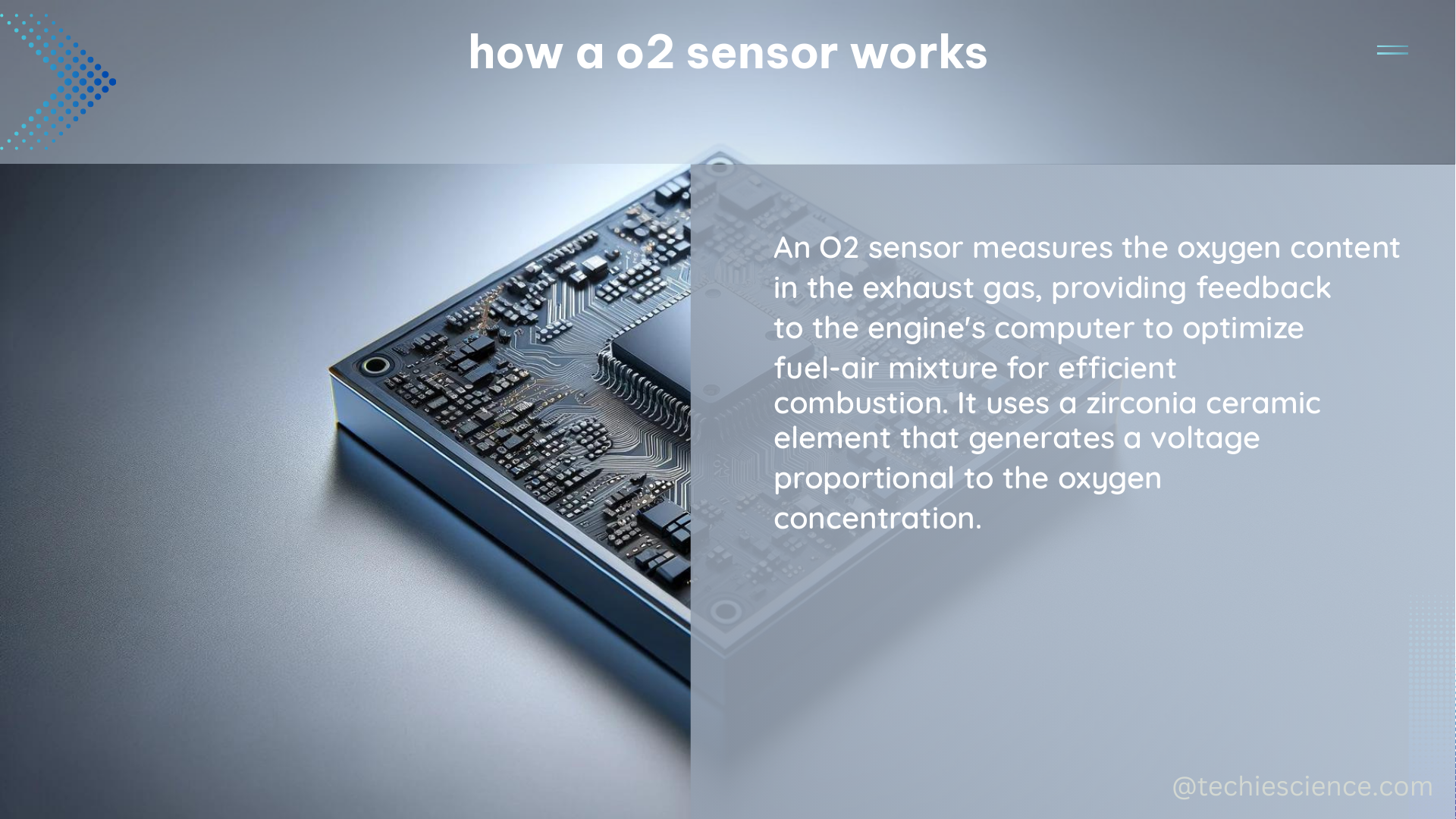An O2 sensor, also known as an oxygen sensor, is a critical component in modern internal combustion engines. It measures the amount of oxygen in the exhaust gas and provides vital information to the engine control unit (ECU) to optimize combustion and minimize emissions. This comprehensive guide delves into the technical details of how an O2 sensor functions, its key specifications, and the steps involved in testing its performance.
Understanding the Basics of O2 Sensor Operation
The primary function of an O2 sensor is to compare the amount of oxygen in the exhaust gas to the amount of oxygen in the ambient air. This comparison is achieved through the sensor’s unique design and the principles of electrochemistry.
At the heart of the O2 sensor is a sensing element, typically made of zirconia (ZrO2), which is exposed to the exhaust gas. The sensing element is surrounded by a porous ceramic layer that allows oxygen to diffuse through it. On the other side of the ceramic layer is a reference air chamber that is open to the ambient air.
The difference in oxygen concentration between the exhaust gas and the reference air chamber creates a voltage potential across the sensing element. This voltage, known as the Nernst voltage, is proportional to the difference in oxygen content and can range from 0.1 to 0.9 volts, indicating a rich to lean fuel mixture.
Key Technical Specifications of O2 Sensors

-
Operating Temperature Range: O2 sensors are designed to withstand the harsh environment of the exhaust system, with an operating temperature range typically between 300 and 1,200 degrees Celsius (572 to 2,192 degrees Fahrenheit).
-
Response Time: The response time of an O2 sensor is crucial for accurate air-fuel ratio control. High-performance sensors can respond to changes in oxygen content within 100 milliseconds, ensuring the ECU can make timely adjustments.
-
Heater Resistance: O2 sensors are equipped with an internal heater to maintain the sensing element at the optimal operating temperature. The heater resistance should be within the manufacturer’s specified range, typically between 10 and 30 ohms.
-
Sensor Resistance: The resistance of the O2 sensor’s sensing element can also be used to diagnose its condition. The resistance should be within the manufacturer’s specifications, often ranging from 500 to 2,000 ohms at operating temperature.
-
Voltage Output: As mentioned earlier, the voltage output of an O2 sensor should fluctuate between 0.1 and 0.9 volts, indicating a rich to lean fuel mixture. A stuck voltage at 0.1 volts may indicate a faulty sensor.
-
Sensor Tip Material: The material used for the sensing element tip can vary, with common options including zirconia (ZrO2), titania (TiO2), and planar ceramic. The choice of material affects the sensor’s performance, durability, and cost.
Testing an O2 Sensor
Proper testing of an O2 sensor is crucial to ensure its functionality and identify any potential issues. Here are the steps involved in testing an O2 sensor:
-
Resistance Check: Use a multimeter to measure the resistance of the O2 sensor, including the heater resistance and the sensing element resistance. The values should be within the manufacturer’s specifications.
-
Voltage Output Check: Connect a digital voltmeter to the O2 sensor’s signal wire and monitor the voltage output. The voltage should fluctuate between 0.1 and 0.9 volts, indicating a rich to lean fuel mixture. If the voltage is stuck at 0.1 volts, the sensor may be faulty.
-
Response Time Test: Some advanced diagnostic tools can measure the O2 sensor’s response time by introducing a sudden change in the air-fuel ratio and monitoring the sensor’s voltage output. The response time should be within the manufacturer’s specifications.
-
Sensor Heating Test: Verify that the O2 sensor’s internal heater is functioning correctly by measuring the heater resistance and ensuring it is within the specified range.
-
Visual Inspection: Carefully inspect the O2 sensor for any physical damage, such as a cracked or corroded sensing element, which could indicate the need for replacement.
By following these testing procedures, you can accurately assess the condition of an O2 sensor and determine if it requires replacement or further troubleshooting.
Conclusion
The O2 sensor is a crucial component in modern internal combustion engines, playing a vital role in optimizing combustion and minimizing emissions. Understanding the technical details of how an O2 sensor works, its key specifications, and the proper testing procedures is essential for maintaining and diagnosing engine performance issues. This comprehensive guide has provided you with the necessary knowledge to become an expert on the inner workings of an O2 sensor.
References:
- Technically Speaking: Understanding how oxygen sensors work to help diagnose fault codes. (2014-11-21). Retrieved from https://www.motortrend.com/how-to/1501-understanding-oxygen-sensors-to-diagnose-fault-codes/
- how 02 sensor works must read !!!!!!!! – LS1TECH. (2008-04-14). Retrieved from https://ls1tech.com/forums/general-lsx-automobile-discussion/902354-how-02-sensor-works-must-read.html
- Making Sense of Sensors: The Oxygen Sensor – Delphi Technologies. (n.d.). Retrieved from https://www.delphiautoparts.com/resource-center/making-sense-of-sensors-the-oxygen-sensor

The lambdageeks.com Core SME Team is a group of experienced subject matter experts from diverse scientific and technical fields including Physics, Chemistry, Technology,Electronics & Electrical Engineering, Automotive, Mechanical Engineering. Our team collaborates to create high-quality, well-researched articles on a wide range of science and technology topics for the lambdageeks.com website.
All Our Senior SME are having more than 7 Years of experience in the respective fields . They are either Working Industry Professionals or assocaited With different Universities. Refer Our Authors Page to get to know About our Core SMEs.